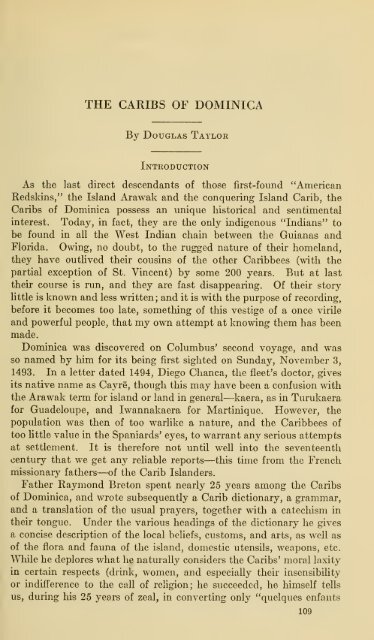You also want an ePaper? Increase the reach of your titles
YUMPU automatically turns print PDFs into web optimized ePapers that Google loves.
THE CARIBS OF DOMINICA<br />
By Douglas Taylor<br />
Introduction<br />
As the last direct descendants <strong>of</strong> those first-found "American<br />
Redskins," the Island Arawak and the conquering Island Carib, the<br />
<strong>Caribs</strong> <strong>of</strong> <strong>Dominica</strong> possess an unique historical and sentimental<br />
interest. Today, in fact, they are the only indigenous "Indians" to<br />
be found in all the West Indian chain between the Guianas and<br />
Florida. Owing, no doubt, to the rugged nature <strong>of</strong> their homeland,<br />
they have outlived their cousins <strong>of</strong> the other Caribbees (with the<br />
partial exception <strong>of</strong> St. Vincent) by some 200 years. But at last<br />
their course is run, and they are fast disappearing. Of their story<br />
little is known and less written; and it is with the purpose <strong>of</strong> recording,<br />
before it becomes too late, something <strong>of</strong> this vestige <strong>of</strong> a once virile<br />
and powerful people, that my own attempt at knowing them has been<br />
made.<br />
<strong>Dominica</strong> was discovered on Columbus' second voyage, and was<br />
so named by him for its being first sighted on Sunday, November 3,<br />
1493. In a letter dated 1494, Diego Chanca, the fleet's doctor, gives<br />
its native name as Cayre, though this may have been a confusion with<br />
the Arawak term for island or land in general—kaera, as in Turukaera<br />
for Guadeloupe, and Iwannakaera for Martinique. However, the<br />
population was then <strong>of</strong> too warlike a nature, and the Caribbees <strong>of</strong><br />
too little value in the Spaniards' eyes, to warrant any serious attempts<br />
at settlement. It is therefore not until well into the seventeenth<br />
century that we get any reliable reports—this time from the French<br />
missionary fathers—<strong>of</strong> the Carib Islanders.<br />
Father Raymond Breton spent nearly 25 years among the <strong>Caribs</strong><br />
<strong>of</strong> <strong>Dominica</strong>, and wrote subsequently a Carib dictionary, a grammar,<br />
and a translation <strong>of</strong> the usual prayers, together with a catechism in<br />
their tongue. Under the various headings <strong>of</strong> the dictionary he gives<br />
a concise description <strong>of</strong> the local beliefs, customs, and arts, as well as<br />
<strong>of</strong> the flora and fauna <strong>of</strong> the island, domestic utensils, weapons, etc.<br />
While he deplores what he naturally considers the <strong>Caribs</strong>' moral laxity<br />
in certain respects (drink, women, and especially their insensibility<br />
or indifference to the call <strong>of</strong> religion; he succeeded, he himself tells<br />
us, during his 25 years <strong>of</strong> zeal, in converting only "quelques enfants<br />
109

















